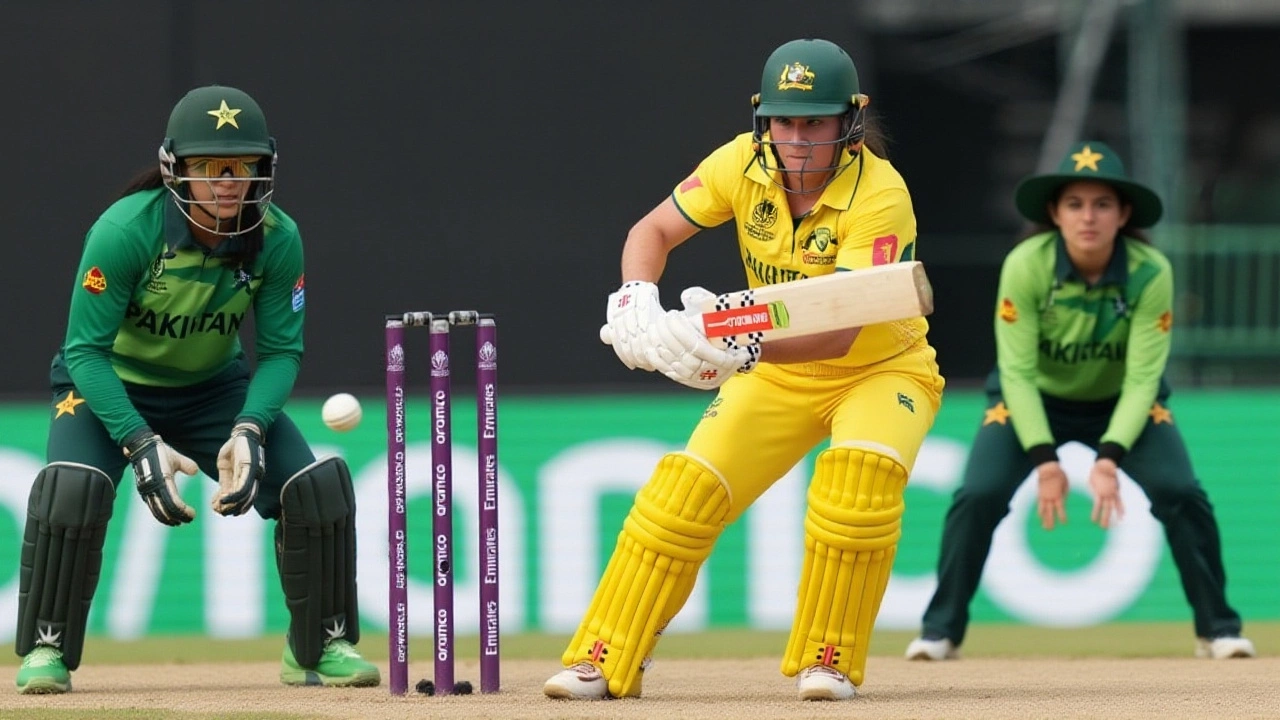When Alyssa Healy, captain of Australia Women walked onto the field at R. Premadasa International Cricket Stadium on October 8, 2025, the stakes were crystal clear: a top‑seeded side looking to cement its supremacy and a fledgling side desperate to break a decades‑long drought. The match was part of the ICC Women’s Cricket World Cup 2025, the tournament’s ninth group‑stage fixture, and it unfolded under a humid Colombo sky that smelled of monsoon‑season rain. By the time the final over was bowled, Australia Women had posted 289/5, while Pakistan Women were bundled out for 142, handing the Aussies a 147‑run victory that reshaped the group table and kept their unbeaten record against Pakistan intact.
Australia’s march to the final has been built on a blend of experienced firepower and depth in spin that suits sub‑continental pitches. Cricket Australia has invested heavily in a spin‑focused development program since the 2020‑21 season, a strategy vindicated by coach Shelley Nitschke’s emphasis on variations that curl sharply on Colombo’s dry surface. Their opponents, managed by the Pakistan Cricket Board, entered the tournament with a mixed bag of talent but have historically struggled on slower tracks, a fact that loomed large after their crushing 73‑run loss to Australia at the 2022 World Cup.
Background: How the Teams Arrived at Colombo
The twelfth edition of the Women’s World Cup kicked off on September 25, 2025, across three Sri Lankan venues – Colombo, Kandy and Galle. Australia entered the group stage as defending champions, having lifted the trophy in 2022 after a dramatic final against England. Their opening matches were clinical: a 112‑run win over South Africa and a narrow 9‑run triumph over West Indies, leaving them top of Group A with six points.
Pakistan, on the other hand, has never progressed beyond the pool phase in its nine appearances. Their campaign began with a modest 45‑run loss to New Zealand, followed by a rain‑curtailed tie against Sri Lanka. The clash with Australia was therefore a litmus test – could the Pakistani side finally crack the five‑match losing streak that stretches back to the inaugural 1997 tournament?
Match Summary: Australia’s Dominant Display
Australia won the toss and elected to bat, a decision that paid off handsomely. Opening pair Beth Mooney and Annabel Sutherland steadied the innings, but it was Ellyse Perry who stole the spotlight, pounding 97 off 112 balls with a blend of drives and cut shots that left the Pakistani bowlers scrambling.
Middle‑order contributions from Tahlia McGrath (68 off 79) and Ashleigh Gardner’s quick‑fire 34 off 22 propelled the total to 289/5 after 50 overs. The partnership between Perry and McGrath added 124 runs for the third wicket, a record stand for the tournament at that point.
Pakistan’s reply never found rhythm. Opening batter Sidra Amin edged a delivery for a caught‑behind in the fifth over, and the second wicket fell at 32 runs when Javeria Khan was trapped LBW after a third‑umpire review overturned a not‑out call. That review, conducted by ICC Elite Panel umpire Richard Illingworth, became the turning point – the decision left Pakistan 72 runs behind with only 20 overs left.
Fast bowler Diana Baig managed a solitary four‑wicket haul, but the bulk of the damage came from Australia’s spinners. Georgia Voll, making her Test debut last year, snared a spectacular catch at mid‑wicket and bowled a tidy spell of 2/21, while leg‑spinner Alana King twisted the ball sharply, finishing with figures of 3/28.
Pakistan were eventually bowled out for 142 in 38.2 overs, a collapse that saw them lose six wickets for just 42 runs between the 18th and 27th overs. Nida Dar’s 33 off 41 balls proved to be the lone bright spot.
Key Performances and Tactical Battles
The spin factor loomed large throughout the game. ICC tournament director Chris Tetley noted after the match that 68% of wickets in Colombo so far have been taken by spinners, a statistic that reinforced Australia’s strategy of loading a spin‑heavy attack.
Australia’s decision to open with the experienced pair of Mooney and Sutherland paid off, giving the middle order the platform to accelerate. Mooney’s sweep off left‑arm spinner Sadia Iqbal was a textbook example of using the crease, earning a crisp applause from the packed stadium.
Pakistan’s analysis team, led by PCB Media Manager Nadeem Muzaffar, had reportedly studied over 200 delivery patterns from Australia’s spinners ahead of the match. Yet the execution fell short – the team struggled to read the subtle variation in turn, especially on the second and fourth days of the tournament when the pitch tends to slow further.

Reactions from Players and Officials
“Our depth in spin resources gives us a strategic advantage on sub‑continental pitches,” said Belinda Clark, Cricket Australia’s performance director and former World Cup‑winning captain. “We trusted our plan, and the players delivered exactly what we needed.”
Pakistan captain Nida Dar remained pragmatic: “We knew the conditions would be challenging. The bowlers did the best they could, but we need to convert our opportunities better if we want a chance in the next matches.”
Commentator Harsha Bhogle drew a parallel to England’s recent victory over South Africa, noting that “aggressive intent early on, especially from the top order, can dictate the rhythm on a spinning track.”
Implications for the Group Stage and Beyond
Australia’s win lifted them to eight points, guaranteeing a spot in the quarter‑finals and leaving the door open for a top‑two finish, which could afford them a more favorable knockout draw. The margin of victory also boosted their net run rate – a critical tiebreaker that could come into play if other teams finish on equal points.
Pakistan, meanwhile, sits at zero points with three matches left. Their only path to the semi‑finals now demands victories over India, New Zealand and Sri Lanka, a steep hill to climb, especially given the fierce competition and the upcoming clash with India on October 12 at the same venue — a match that also carries intense political overtones.
Looking ahead, Australia will travel to Galle to face New Zealand on October 11. The Galle pitch historically favors seamers, which could test Australia’s pace attack, featuring fast bowler Megan Schutt. Pakistan’s next hurdle is the high‑pressure India encounter; a win would not only resurrect their campaign but also spark a massive fan response back home.

Key Facts
- Venue: R. Premadasa International Cricket Stadium, Colombo.
- Result: Australia Women 289/5 (50 overs) defeated Pakistan Women 142 (38.2 overs) by 147 runs.
- Top scorer: Ellyse Perry – 97 runs.
- Best bowler for Australia: Alana King – 3/28.
- Pakistan’s highest individual score: Nida Dar – 33 runs.
Frequently Asked Questions
How does this result affect Australia’s chances of reaching the semi‑finals?
The 147‑run win pushes Australia to eight points, guaranteeing a quarter‑final spot and giving them a strong net‑run‑rate edge. Even if other teams finish level on points, Australia’s superior run rate will keep them in the top two, potentially securing a more favorable knockout opponent.
What are the key reasons behind Pakistan’s collapse?
Pakistan struggled to read the spin on a drying Colombo pitch, losing six wickets for just 42 runs in the middle overs. The third‑umpire review that dismissed Javeria Khan shifted momentum, and the team’s inability to rotate strike compounded the pressure.
Who were the standout performers for Australia?
Ellyse Perry’s near‑century (97) and Tahlia McGrath’s 68 were the batting backbone. On the bowling side, Alana King’s three wickets and Georgia Voll’s sharp fielding contributed heavily to the victory.
When is Pakistan’s next match and why is it crucial?
Pakistan faces India on October 12, 2025, at the same Colombo venue. A win would be their only realistic shot at staying alive in the tournament, as they must win all remaining group games to have any chance of advancing.
What does the match tell us about spin’s role in the tournament?
With 68% of wickets in Colombo taken by spinners, the conditions heavily favor quality spin bowling. Teams with strong spin units, like Australia, gain a tactical edge, while sides less adept at spin must adapt quickly or risk heavy defeats.
